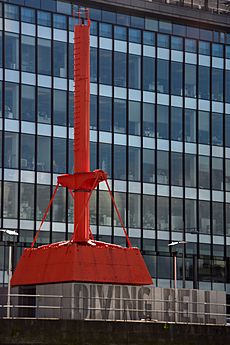Bindon Blood Stoney facts for kids
Quick facts for kids
Bindon Blood Stoney
|
|
|---|---|

Plaque to Stoney at the Dublin Port Centre
|
|
| Born | 13 June 1828 Oakley Park, County Offaly
|
| Died | 5 May 1909 (aged 96) |
| Occupation | Engineer |
| Engineering career | |
| Discipline | Civil |
| Institutions | Institution of Civil Engineers of Ireland (president), Royal Society, Institution of Civil Engineers |
| Projects | Dublin Harbour |
Bindon Blood Stoney (born June 13, 1828, in County Offaly, Ireland – died May 5, 1909, in Dublin) was a brilliant Irish engineer. He was also a talented astronomer who made important discoveries about space.
Contents
His Family of Scientists
Bindon Blood Stoney was part of a very clever family! His parents were George Stoney and Anne Blood. He married Susannah Frances Walker in 1879, and they had four children together. He is buried in Mount Jerome cemetery.
His brother was George Johnstone Stoney, a famous physicist. He is known for inventing the word electron for the tiny unit of electricity. Bindon was also the uncle of another Irish physicist, George Francis FitzGerald. His nieces, Edith Anne Stoney and Florence Stoney, were also pioneers. Edith was a medical physicist, and Florence was the first female radiologist in the United Kingdom. Both helped in hospitals during World War I.
Looking at the Stars
Before he became an engineer, Bindon Stoney spent time studying the stars. From 1850 to 1852, he helped William Parsons, 3rd Earl of Rosse at Parsonstown. There, he carefully mapped the spiral shape of the Andromeda Galaxy. He also observed many new objects in space, including 105 NGC objects and 8 IC objects.
Building Big Things: His Engineering Career
Bindon's engineering journey began in Spain. From 1852 to 1853, he worked on surveys for a railway line. When he came back to Ireland in 1854, he became the engineer for the Boyne Viaduct. This was a huge railway bridge that was finished in 1855. At the time, it had the longest span and the longest girders in the world!
Bindon did amazing work on this bridge. He used a new way to build metal bridges with special shock-absorbing iron bars. This was a very new idea at the time. His work on this bridge led to his famous two-volume book, The theory of strains in girders and similar structures. People nicknamed it 'Stoney on strains'.
Bindon became a member of the Institution of Civil Engineers (ICE) in 1858.
Transforming Dublin Port
In 1856, Bindon started working for the Ballast Board in Dublin. He quickly showed he was a creative engineer. In 1868, he became the first chief engineer of the new Dublin Port and Docks Board. He had a plan to make Dublin Port much better and more efficient.
Bindon designed a large machine to dig out the harbour. He rebuilt almost 7,000 feet of quay walls along the River Liffey. This changed the port from having areas that depended on tides to deep-water berths. This meant bigger ships could come in at any time. He also made the northern quays longer and started building the Alexandra Basin in 1871.
Stoney also designed and built two major bridges over the River Liffey. From 1872 to 1875, he rebuilt Essex Bridge, which was renamed Grattan Bridge. Then, from 1877 to 1880, he redesigned Carlisle Bridge, which became O'Connell Bridge. He also built a new iron swing bridge called Beresford Bridge.
He even invented a special diving bell and new ways to use precast concrete. Towards the end of his career, he built the North Bull Lighthouse (1877–80). This lighthouse helped guide ships safely into Dublin Port. Bindon retired in 1898 after a long and successful career.
Awards and Recognition
Bindon Stoney received many honors for his incredible work. He joined the Royal Irish Academy in 1857. University College Dublin gave him an honorary degree. He was also elected President of the Institution of Civil Engineers of Ireland in 1871.
In 1874, he won the Telford medal for his work on the northern quays. On June 2, 1881, he was elected a Fellow of the Royal Society, which is a very high honor for scientists.
Today, Stoney Road in East Wall, Dublin, is named after him to remember his contributions.


